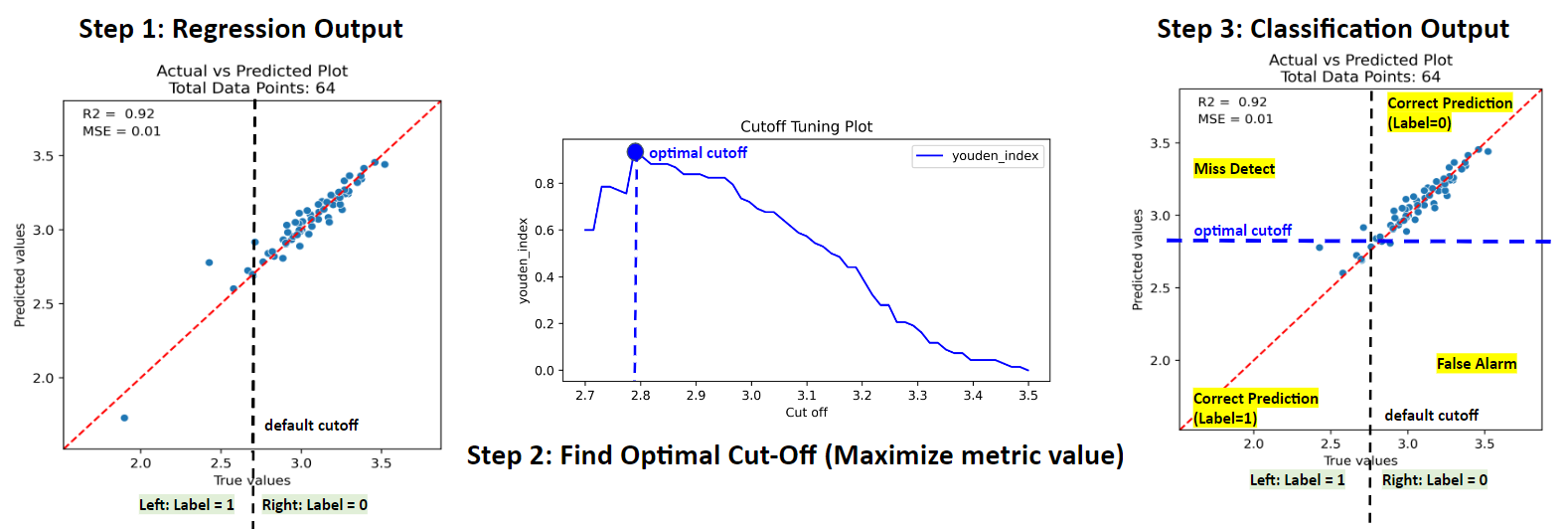A Python package for simultaneous regression and binary classification for educational analytics.
Project description

Empowering Educators with An Open-Source Tool for Simultaneous Grade Prediction and At-risk Student Identification
This Python package, based on the paper "Early Detecting and Supporting At-Risk University Students through Data Analytics and Intervention" combines regression analysis with binary classification to forecast student academic outcomes
0. Package Installation
This package requires:
- Python (>= 3.9)
- NumPy
- scikit-learn
- Matplotlib
- Seaborn
1st Step: Install all the dependencies using the command:
pip install numpy scikit-learn matplotlib seaborn
2nd Step: Install the dualPredictor package via PyPI or GitHub (Recommended). Choose one of the following methods:
pip install dualPredictor
pip install git+https://github.com/098765d/dualPredictor.git
1. Introduction
Designed to simplify the implementation of advanced algorithms, this package allows users to train models, make predictions, and visualize results with just 1 line of code with their own dataset. This accessibility benefits educators with varying levels of IT expertise, making sophisticated algorithms readily available. The package is easy to install via GitHub and PyPI:
PyPI Link: https://pypi.org/project/dualPredictor/
Github Repo: https://github.com/098765d/dualPredictor/
Ensuring that educators can integrate advanced analytics into their workflows seamlessly.
-
Step 1: Grade Prediction Using the Trained Regressor (Fig 1, Step 1) fit the linear model f(x) using the training data, and grade prediction can be generated from the fitted model
y\_pred = f(x) = \sum_{j=1}^{M} w_j x_j + b -
Step 2: Determining the Optimal Cut-off (Fig 1, Step 2)
The goal is to find the cut-off (c) that maximizes the binary classification accuracy. Firstly, the user specifies the metric type used for the model (e.g., Youden index) and denotes the metric function as g(y_true_label, y_pred_label), where:
\text{optimal\_cut\_off} = \arg\max_c g(y_{\text{true\_label}}, y_{\text{pred\_label}}(c))This formula searches for the cut-off value that produces the highest value of the metric function g, where:
- c: The tunned cut-off that determines the y_pred_label
- y_true_label: True label of the data point based on the default cut-off (e.g., 1 for at-risk, 0 for normal)
- y_pred_label: Predicted label of the data point based on the tunned cut-off value
-
Step 3: Binary Label Prediction: (Fig 1, Step 3)
- y_pred_label = 1 (at-risk): if y_pred < optimal_cut_off
- y_pred_label = 0 (normal): if y_pred >= optimal_cut_off

2. The Model Object (Parameters, Methods, and Attributes)
The dualPredictor package aims to simplify complex models for users of all coding levels. It adheres to the syntax of the scikit-learn library and simplifies model training by allowing you to fit the model with just one line of code. The core part of the package is the model object called DualModel, which can be imported from the dualPredictor library.
Table 1: Model Parameters, Methods, and Attributes
| Category | Name | Description |
|---|---|---|
| Parameters | model_type |
Type of regression model to use. For example: - 'lasso' (Lasso regression) |
metric |
Metric is used to optimize the cut-off value. For example: - 'youden_index' (Youden's Index) |
|
default_cut_off |
Initial cut-off value used for binary classification. For example: 2.50 | |
| Methods | fit(X, y) |
- X: The input training data, pandas data frame. - y: The target values (predicted grade). - Returns: Fitted DualModel instance |
predict(X) |
- X: The input data for predeiction, pandas data frame. | |
| Attributes | alpha_ |
The value of penalization in Lasso model |
coef_ |
The coefficients of the model | |
intercept_ |
The intercept value of the model | |
feature_names_in_ |
Names of features during model training | |
optimal_cut_off |
The optimal cut-off value that maximizes the metric |
Example of the Model Object
from dualPredictor import DualModel
# Initialize the model and specify the parameters
model = DualModel(model_type='lasso', metric='youden_index', default_cut_off=2.5)
# Using model methods for training and predicting
# Simplify model training by calling fit method with one line of code
model.fit(X_train, y_train)
grade_predictions, class_predictions = model.predict(X_train)
# Accessing model attributes (synthetic result for demo only)
print("Alpha (regularization strength):", model.alpha_)
Alpha (regularization strength): 0.12
print("Model coefficients:", model.coef_)
Model coefficients: [0.2, -0.1, 0.3, 0.4]
print("Model intercept:", model.intercept_)
Model intercept: 2.5
print("Feature names:", model.feature_names_in_)
Feature names: ['feature1', 'feature2', 'feature3', 'feature4']
print("Optimal cut-off value:", model.optimal_cut_off)
Optimal cut-off value: 2.56
3. Quick Start
Note: Results are synthetic and for demonstration purposes only
Step 0. Prepare your Dataset: Prepare the X_train, X_test, y_train, y_test
Step 1. Import the Package: Import the dualPredictor package into your Python environment.
from dualPredictor import DualModel, model_plot
Step 2. Model Initialization: Create a DualModel instance
model = DualModel(model_type='lasso', metric='youden_index', default_cut_off=2.5)
Step 3. Model Training: Fit the model using X_train & y_train
model.fit(X_train, y_train)
Step 4. Model Predictions: Generate predictions on X_test
# example for demo only, model prediction dual output
y_test_pred,y_test_label_pred = model.predict(X_test)
# Example of model's 1st output = predicted scores (regression result)
y_test_pred
array([3.11893389, 3.06013236, 3.05418893, 3.09776197, 3.14898782,
2.37679417, 2.99367804, 2.77202421, 2.9603209 , 3.01052573])
# Example of model's 2nd output = predicted at-risk status (binary label)
y_test_label_pred
array([0, 0, 0, 0, 0, 1, 0, 0, 1, 0])
Step 5.Visualization: Visualize the model's performance with just one line of code
# Scatter plot for regression analysis
model_plot.plot_scatter(y_pred, y_true)
# Confusion matrix for binary classification
model_plot.plot_cm(y_label_true, y_label_pred)
# Model's global explanation: Feature importance plot
model_plot.plot_feature_coefficients(coef=model.coef_, feature_names=model.feature_names_in_)

References
[1] Fluss, R., Faraggi, D., & Reiser, B. (2005). Estimation of the Youden Index and its associated cutoff point. Biometrical Journal: Journal of Mathematical Methods in Biosciences, 47(4), 458-472.
[2] Hoerl, A. E., & Kennard, R. W. (1970). Ridge regression: Biased estimation for nonorthogonal problems. Technometrics, 12(1), 55-67.
[3] Lundberg, S. M., & Lee, S. I. (2017). A unified approach to interpreting model predictions. Advances in neural information processing systems, 30.
[4] Pedregosa, F., Varoquaux, G., Gramfort, A., Michel, V., Thirion, B., Grisel, O., ... & Duchesnay, É. (2011). Scikit-learn: Machine learning in Python. The Journal of Machine Learning Research, 12, 2825-2830.
[5] Tibshirani, R. (1996). Regression shrinkage and selection via the lasso. Journal of the Royal Statistical Society Series B: Statistical Methodology, 58(1), 267-288.
Project details
Release history Release notifications | RSS feed
Download files
Download the file for your platform. If you're not sure which to choose, learn more about installing packages.
Source Distribution
Built Distribution
File details
Details for the file dualpredictor-0.0.23.tar.gz.
File metadata
- Download URL: dualpredictor-0.0.23.tar.gz
- Upload date:
- Size: 14.9 kB
- Tags: Source
- Uploaded using Trusted Publishing? Yes
- Uploaded via: twine/5.1.0 CPython/3.12.4
File hashes
| Algorithm | Hash digest | |
|---|---|---|
| SHA256 | 46ec7fbfb245444dfaf00ba6ac4f3bcce95e4c23825a77dab5e66aca0afa9b62 |
|
| MD5 | 4f7f60f3d63704e40424060ea629d0c4 |
|
| BLAKE2b-256 | 1aa8535b3b8c43aaa92a5041823405a83e0edc4cb29f0130bcbe90c43fc12053 |
File details
Details for the file dualPredictor-0.0.23-py3-none-any.whl.
File metadata
- Download URL: dualPredictor-0.0.23-py3-none-any.whl
- Upload date:
- Size: 12.7 kB
- Tags: Python 3
- Uploaded using Trusted Publishing? Yes
- Uploaded via: twine/5.1.0 CPython/3.12.4
File hashes
| Algorithm | Hash digest | |
|---|---|---|
| SHA256 | 3ed8e8083df696f496f5297510744fed6c407c1b9610a3c3f2619cb41b2438f0 |
|
| MD5 | 69be227f5b19ed691f40c4cde5c32076 |
|
| BLAKE2b-256 | 76658ad44e5226ea4ad04543c5d3edba10b4fbef9b637a16a000fa59ed3a3f38 |











